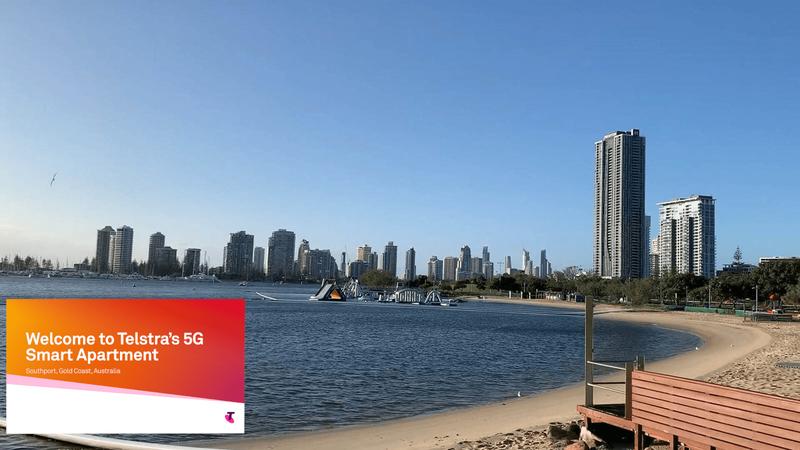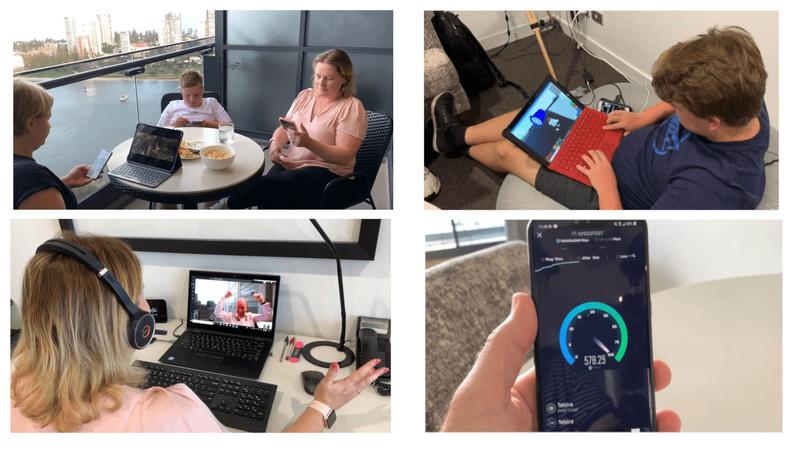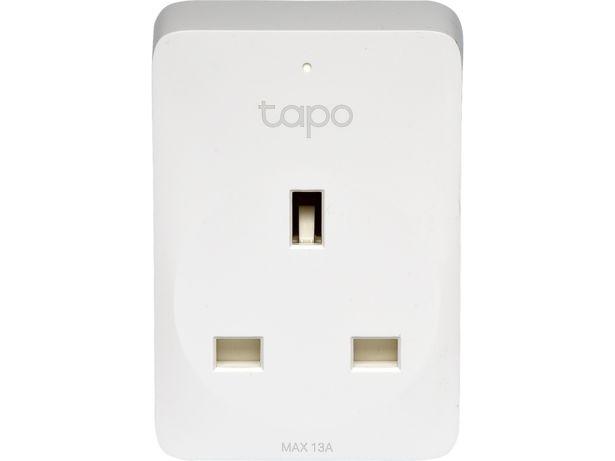5G vs. 50 devices: Testing our 5G network and EME in a ‘smart apartment’
There’s been a lot of buzz around 5G this year. You might have also read a few other not so accurate facts around 5G. We thought we’d put it all to the test again to show you the facts about 5G and electromagnetic energy (EME) in a very high-tech connected home.
If you don’t know what EME is, it stands for ‘electromagnetic energy’. It occurs naturally in our everyday lives – the Sun and the Earth itself, for example, both emit EME. The electromagnetic spectrum enables technologies like radio communications, Wi-Fi and television. The vast majority of EME is low level and all consumer devices are tested for compliance, with safety limits set in Australia by an independent body called ARPANSA.
We wanted to answer two main questions doing with this testing: how hard can you push the data speeds on our 5G network, and what sort of EME levels are created by doing this?
Our 5G ‘smart apartment’ on the Gold Coast
To answer these questions, we set up a 5G and Wi-Fi-connected smart apartment on the Gold Coast with over 50 connected devices, then invited a family with teenagers and their friends to stay over a long weekend to access high-speed unlimited internet and data over 5G.
The teenagers thought Christmas had come early and eagerly took up the challenge to use as many devices as possible over the weekend – when their friends arrived for a Saturday dinner party the next big challenge was to ‘max out the network’ playing games, streaming in 4K and downloading big files, all at the same time. (Something the eldest boy was very excited to put to the test!)
Overall, the EME levels from 5G, 4G and Wi-Fi in a smart apartment with over 50 connected devices were all very low, even under high utilisation when being ‘maxed out’ – the EME results measured were more than 10,000 times below the public safety limits. As a point of comparison, we measured higher EME levels from the local FM and TV broadcasts, and also from a baby monitor in the bedroom.
(TV & FM = 9000 times below the public safety limit, baby monitor = 123 times below the public safety limit)
How we set up the apartment
The apartment had 2 bedrooms, a large living and kitchen area, home office workstation, dedicated media & theatre room, and balconies at the front and rear – not a bad place to spend a long weekend!
When we say we decked the place out with connected devices, we really meant it. This included smart TVs, smart speakers, 5G mobile phones, three HTC 5G Wi-Fi routers to connect all the Wi-Fi devices, gaming consoles, Google Home Mini smart speakers, Google Nest smart cameras, a smart doorbell, baby monitor, smart scales in the kitchen, smart lights, smart plugs, and a workstation with laptops, printer, wireless headsets, and a video camera… There was a lot.
In total we safely configured 58 devices to operate in the apartment over 5G, 4G, and Wi-Fi.
How did the network handle all of this?
The 5G network delivered great performance for all the connected devices, with a typical speed ranging from 300-500 Mbps. This meant gaming, streaming movies, sharing updates and connecting with friends on social media all at the same time happened without breaking a sweat – really pushing the teenagers to try and find enough to do to max it out!

The home office also performed very well for the kids to catch up on school assignments and for the parents to work on the Monday. (That was the trade-off for a long weekend on the Gold Coast!)
What about that EME?
To measure the EME levels in the apartment we set up 2 fixed EME monitoring stations, one in the living and kitchen area, and the other in the media room. Most of the activity occurred in the living and kitchen area. The monitoring devices we used continuously recorded the EME levels and we even used a third portable EME monitoring device to measure the EME on the balconies and other locations in the apartment.
Outside of the apartment we measured the EME from the individual devices in a laboratory to determine what the level from each device was at a close distance.
What about the EME results from these devices?
Overall, the background EME levels from the mobile and Wi-Fi connections were very low.
The highest EME levels measured inside the apartment were in the living and kitchen area during the dinner party when everyone was trying their best to max the network out, where we recorded a total of just 0.008% of the EME safety limit.
This is more than 10,000 times below the public EME safety limit and included all the 5G, 4G, and 5G powered Wi-Fi signals combined.
For perspective, the background EME levels measured from the local TV and FM radio stations on the balcony was 0.011% – which is slightly higher than the EME from all the 5G, 4G and Wi-Fi inside the apartment during the period when it was maxed out.
When testing all devices in the apartment individually, the average EME level from the baby monitor in the bedroom was 0.813% – this result comes from the standard test for a device of its kind, measured 20cm from the device.
Did they manage to max it out?
They sure did! They really needed to put their thinking caps on to find enough to stream and download, but they got there.
During the Saturday afternoon, our lucky teenagers gaming, using mobiles and laptops and watching movies managed to record similar 5G EME levels to a synthetic network test that we had previously performed, where we loaded the 5G network to near maximum capacity.
The results measured inside the living room showed the 5G EME levels were very similar. Nice work!
What do our test results mean for families and homes with many connected devices?
Our EME testing demonstrates that even under very high utilization – with over 50 connected devices using 5G, 4G and Wi-Fi – the EME levels are very low and well below the EME safety limits. This should provide reassurance to families, particularly when everyone is at home working, schooling, entertaining and connecting online.
Now for the nerdy stuff
The chart below shows the variation in EME levels on the Saturday during the dinner party and on the Sunday during more normal family usage.
The green plot below is Wi-Fi and the blue plot is 5G, and you can see that EME levels are more than 10,000 times below the public safety limits.
How the EME test devices work
The EME testing was conducted using Narda SRM3006 frequency selective spectrum analyzers.
Each spectrum analyser was set up to continuously ‘sweep’ and record the EME levels over the 700MHz – 3600MHz bands, then record the 1-minute average EME level. Each 1-minute average reading consisted of approximately 40 sweeps.
The 1-minute average EME readings can then be post-processed to give a six-minute average EME level – this is the procedure as required by the current Australian EME safety standard set by ARPANSA.
The connected devices were separately tested in our laboratory to measure the EME levels close to the device. The recommended distance for testing these types of devices that are not intended to be used against the head or body (like a mobile phone) is 20cm, as specified by the Australian Communications and Media Authority.
We connected each device and measured the peak and average EME levels at 20cm from the device. The highest average EME level recorded was from the baby monitor (0.813%) and the lowest EME level recorded was the smart power board (0.00008%).
You can check out our full testing report to find out more about this exercise.
And if you’re interested in more of the behind the scenes on how we did it, we have it all here for you to check out.



